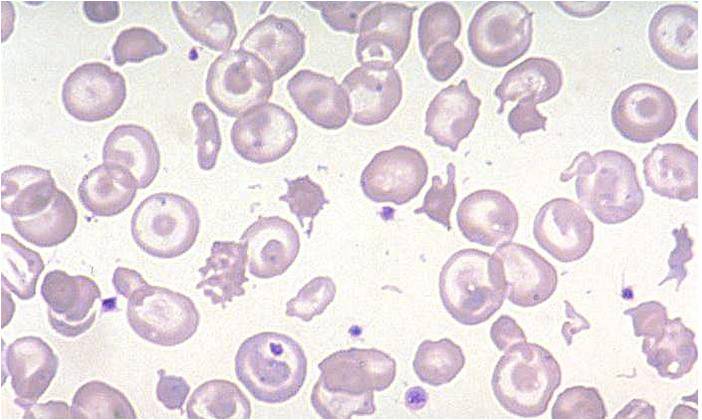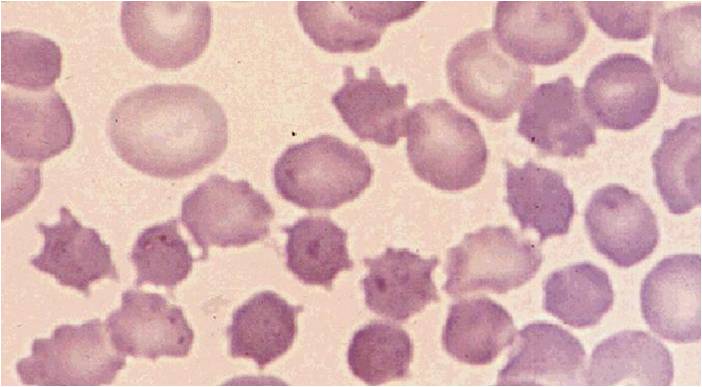Acanthocytosis: Difference between revisions
No edit summary |
No edit summary |
||
| Line 14: | Line 14: | ||
}} | }} | ||
{{SI}} | {{SI}} | ||
'''Editor-in-Chief''' {{MUT}} | |||
{{Editor Help}} | {{Editor Help}} | ||
| Line 20: | Line 22: | ||
==Overview== | ==Overview== | ||
'''Acanthocytosis''' is a digestive disorder that is characterized by the absence of [[very low density lipoprotein]]s ([[VLDL]]) and [[chylomicron]]s in the plasma. | '''Acanthocytosis''' is a digestive disorder that is characterized by the absence of [[very low density lipoprotein]]s ([[VLDL]]) and [[chylomicron]]s in the plasma. [[Acanthocyte]] is a general term meaning 'spiny cell'. AKA "spur cell" in more severe cases | ||
In human biology and [[medicine]], the term refers to pathological [[red blood cell]]s, which are coarse and irregularly crenelated resembling many-pointed stars. They are seen on [[blood film]]s in, among others, [[lipid]] abnormalities, [[liver]] disease, [[chorea acanthocytosis]], [[McLeod syndrome]] and several inherited neurological disorders, such as [[neuroacanthocytosis]]. | |||
== | == Causes == | ||
Acanthocytosis is a red cell phenotype associated with various underlying conditions. The most frequent and most significant conditions include abetalipoproteinemia (Bassen-Kornzweig syndrome) and spur cell hemolytic anemia of severe liver disease. Other, less frequent conditions include the following: | |||
*Neuroacanthocytosis | |||
*Anorexia nervosa and other malnutrition states | |||
*Infantile pyknocytosis | |||
*McLeod syndrome | |||
*In(Lu) null Lutheran phenotype | |||
*Hypothyroidism | |||
*Idiopathic neonatal hepatitis | |||
*Myxedema | |||
*Transient hemolysis and stomatocytosis in individuals with alcoholism and mild hemolysis and spherocytosis in individuals with congestive splenomegaly | |||
*Homozygous familial hypobetalipoproteinemia | |||
*Zieve syndrome | |||
*Chronic granulomatous disease (CGD) associated with McLeod red cell phenotype | |||
== Pathophysiology & Etiology== | == Pathophysiology & Etiology== | ||
The imbalance in membrane lipids due to various abnormalities mainly in the liver, cause cells to stiffen, wrinkle and form spicules. | |||
=== History and Symptoms === | |||
Patients with acanthocytosis may have a history of chronic diarrhea with pale, foul-smelling, and bulky stools; loss of appetite and vomiting; and slow weight gain and decreased growth, possibly including a bleeding tendency. Patients may report symptoms of ataxia, tremors, and visual abnormalities or jaundice, abdominal pain, pallor, dark urine, and recurrent infections. Adolescents and adults may report dyskinesias, specifically orolingual, and cognitive deterioration. | |||
=== Physical Examination === | === Physical Examination === | ||
*Hematologic | |||
**[[Pallor]] | |||
**[[Jaundice]] | |||
**[[Bleeding]] | |||
**[[Lymphadenopathy]] | |||
*Ocular | |||
**Progressive retinitis pigmentosa with loss of night vision, visual acuity, and color vision | |||
**Nystagmus after age 10 years | |||
**Ophthalmoplegia with strabismus | |||
**Progressive exotropia | |||
**[[Cataracts]] | |||
*GI | |||
**[[Abdominal distention]] | |||
**Failure to thrive, with short stature and decreased weight | |||
**[[Hepatomegaly]] | |||
**[[Splenomegaly]] | |||
**[[Ascites]] | |||
*Neurologic | |||
**Loss of deep tendon reflexes | |||
**Decreased sensation to touch, pain, temperature, and position | |||
**Stocking-glove distribution of hypoesthesia | |||
**Decreased muscle strength | |||
**Intention tremors and progressive ataxia with clumsiness and gait disturbances, dysarthria, dysdiadochokinesis, and dysmetria | |||
**Chorea | |||
**Mental retardation, cognitive decline, neuropsychological abnormalities | |||
**Altered mental status | |||
**[[ Fatigue]] | |||
**Cold intolerance | |||
**Skin palmar erythema | |||
**Spider [[angiomas]] | |||
**Abdominal wall collateral veins | |||
**[[Edema]] | |||
**Recurrent skin infections | |||
*Skeletomuscular | |||
**[[Muscular atrophy]] | |||
**Muscle contractures | |||
**[[Kyphoscoliosis]] | |||
**Pes cavus | |||
**Pes equinovarus | |||
=== Laboratory Findings === | === Laboratory Findings === | ||
In human biology and medicine, the term refers to pathological red blood cells, which are coarse and irregularly crenelated resembling many-pointed stars. They are seen on blood films in, among others, lipid abnormalities, liver disease, chorea acanthocytosis, McLeod syndrome and several inherited neurological disorders, such as neuroacanthocytosis. | |||
= | <div align="left"> | ||
<gallery heights="175" widths="175"> | |||
Image:Acanthocytes 0002.jpg|Acanthocytes | |||
Image:Acanthocytes 0001.jpg|Acanthocytes | |||
</gallery> | |||
</div> | |||
==" | |||
{{SIB}} | {{SIB}} | ||
Revision as of 16:50, 16 June 2009
| Acanthocytosis |
|
WikiDoc Resources for Acanthocytosis |
|
Articles |
|---|
|
Most recent articles on Acanthocytosis Most cited articles on Acanthocytosis |
|
Media |
|
Powerpoint slides on Acanthocytosis |
|
Evidence Based Medicine |
|
Clinical Trials |
|
Ongoing Trials on Acanthocytosis at Clinical Trials.gov Trial results on Acanthocytosis Clinical Trials on Acanthocytosis at Google
|
|
Guidelines / Policies / Govt |
|
US National Guidelines Clearinghouse on Acanthocytosis NICE Guidance on Acanthocytosis
|
|
Books |
|
News |
|
Commentary |
|
Definitions |
|
Patient Resources / Community |
|
Patient resources on Acanthocytosis Discussion groups on Acanthocytosis Patient Handouts on Acanthocytosis Directions to Hospitals Treating Acanthocytosis Risk calculators and risk factors for Acanthocytosis
|
|
Healthcare Provider Resources |
|
Causes & Risk Factors for Acanthocytosis |
|
Continuing Medical Education (CME) |
|
International |
|
|
|
Business |
|
Experimental / Informatics |
Editor-in-Chief M.Umer Tariq [1]
Please Take Over This Page and Apply to be Editor-In-Chief for this topic: There can be one or more than one Editor-In-Chief. You may also apply to be an Associate Editor-In-Chief of one of the subtopics below. Please mail us [2] to indicate your interest in serving either as an Editor-In-Chief of the entire topic or as an Associate Editor-In-Chief for a subtopic. Please be sure to attach your CV and or biographical sketch.
Related Key Words and Synonyms:
Overview
Acanthocytosis is a digestive disorder that is characterized by the absence of very low density lipoproteins (VLDL) and chylomicrons in the plasma. Acanthocyte is a general term meaning 'spiny cell'. AKA "spur cell" in more severe cases In human biology and medicine, the term refers to pathological red blood cells, which are coarse and irregularly crenelated resembling many-pointed stars. They are seen on blood films in, among others, lipid abnormalities, liver disease, chorea acanthocytosis, McLeod syndrome and several inherited neurological disorders, such as neuroacanthocytosis.
Causes
Acanthocytosis is a red cell phenotype associated with various underlying conditions. The most frequent and most significant conditions include abetalipoproteinemia (Bassen-Kornzweig syndrome) and spur cell hemolytic anemia of severe liver disease. Other, less frequent conditions include the following:
- Neuroacanthocytosis
- Anorexia nervosa and other malnutrition states
- Infantile pyknocytosis
- McLeod syndrome
- In(Lu) null Lutheran phenotype
- Hypothyroidism
- Idiopathic neonatal hepatitis
- Myxedema
- Transient hemolysis and stomatocytosis in individuals with alcoholism and mild hemolysis and spherocytosis in individuals with congestive splenomegaly
- Homozygous familial hypobetalipoproteinemia
- Zieve syndrome
- Chronic granulomatous disease (CGD) associated with McLeod red cell phenotype
Pathophysiology & Etiology
The imbalance in membrane lipids due to various abnormalities mainly in the liver, cause cells to stiffen, wrinkle and form spicules.
History and Symptoms
Patients with acanthocytosis may have a history of chronic diarrhea with pale, foul-smelling, and bulky stools; loss of appetite and vomiting; and slow weight gain and decreased growth, possibly including a bleeding tendency. Patients may report symptoms of ataxia, tremors, and visual abnormalities or jaundice, abdominal pain, pallor, dark urine, and recurrent infections. Adolescents and adults may report dyskinesias, specifically orolingual, and cognitive deterioration.
Physical Examination
- Hematologic
- Ocular
- Progressive retinitis pigmentosa with loss of night vision, visual acuity, and color vision
- Nystagmus after age 10 years
- Ophthalmoplegia with strabismus
- Progressive exotropia
- Cataracts
- GI
- Abdominal distention
- Failure to thrive, with short stature and decreased weight
- Hepatomegaly
- Splenomegaly
- Ascites
- Neurologic
- Loss of deep tendon reflexes
- Decreased sensation to touch, pain, temperature, and position
- Stocking-glove distribution of hypoesthesia
- Decreased muscle strength
- Intention tremors and progressive ataxia with clumsiness and gait disturbances, dysarthria, dysdiadochokinesis, and dysmetria
- Chorea
- Mental retardation, cognitive decline, neuropsychological abnormalities
- Altered mental status
- Fatigue
- Cold intolerance
- Skin palmar erythema
- Spider angiomas
- Abdominal wall collateral veins
- Edema
- Recurrent skin infections
- Skeletomuscular
- Muscular atrophy
- Muscle contractures
- Kyphoscoliosis
- Pes cavus
- Pes equinovarus
Laboratory Findings
In human biology and medicine, the term refers to pathological red blood cells, which are coarse and irregularly crenelated resembling many-pointed stars. They are seen on blood films in, among others, lipid abnormalities, liver disease, chorea acanthocytosis, McLeod syndrome and several inherited neurological disorders, such as neuroacanthocytosis.

